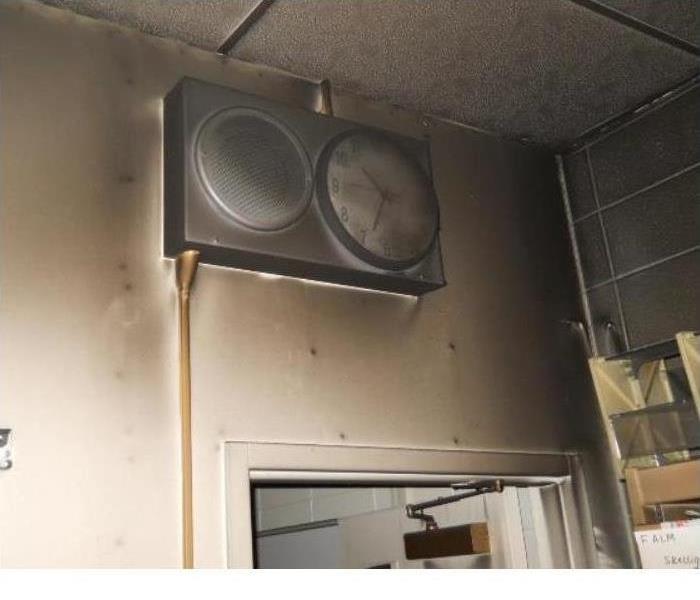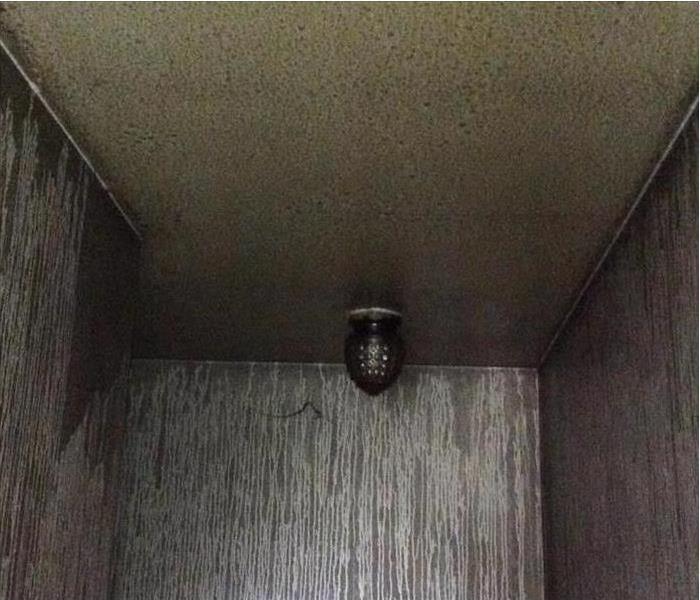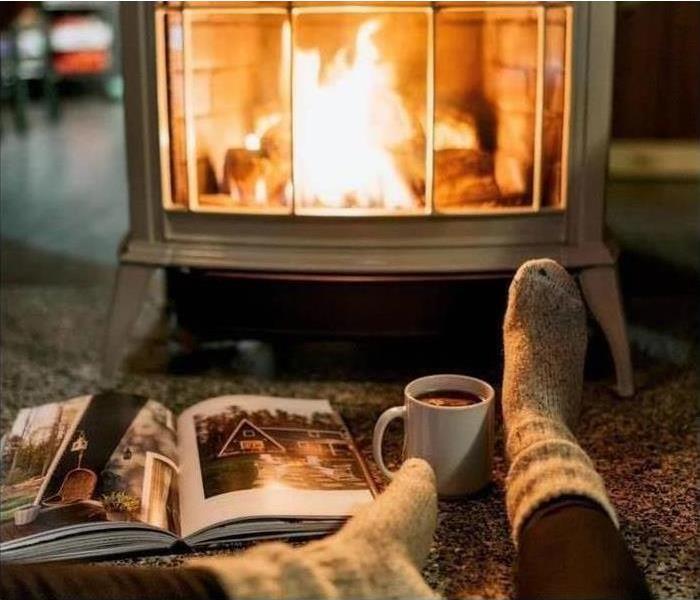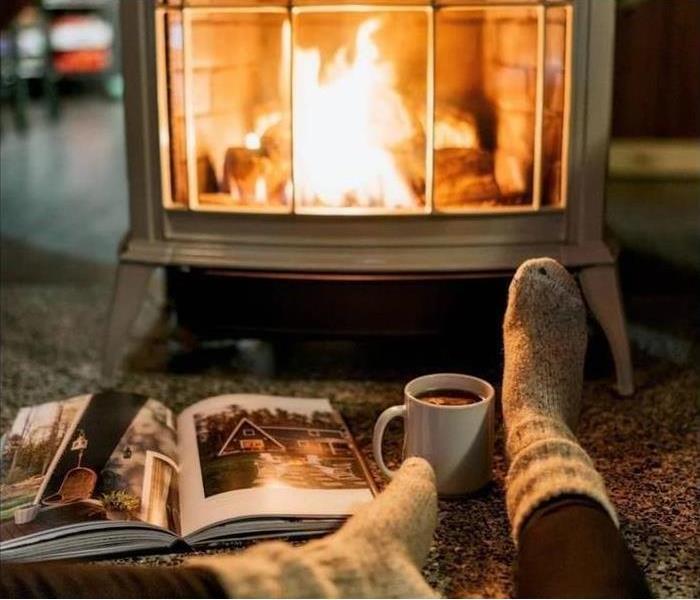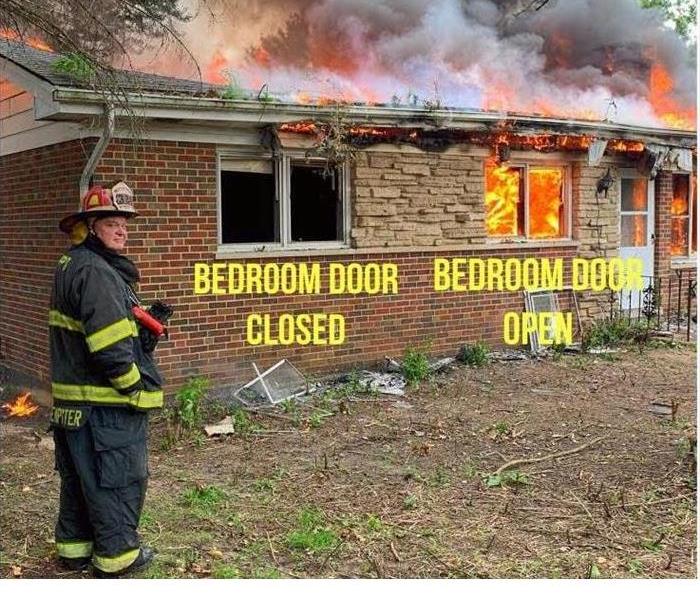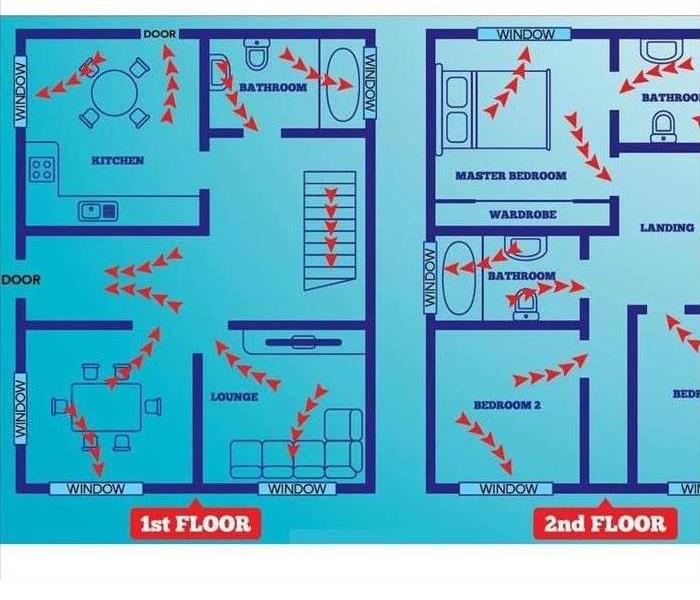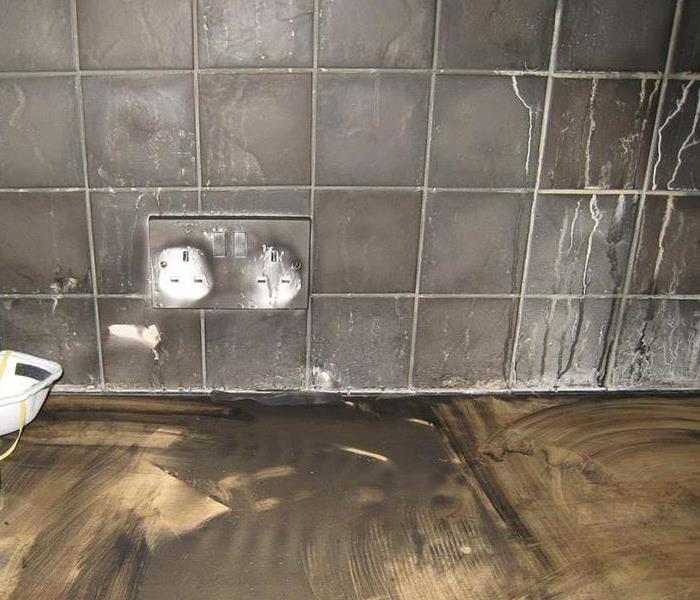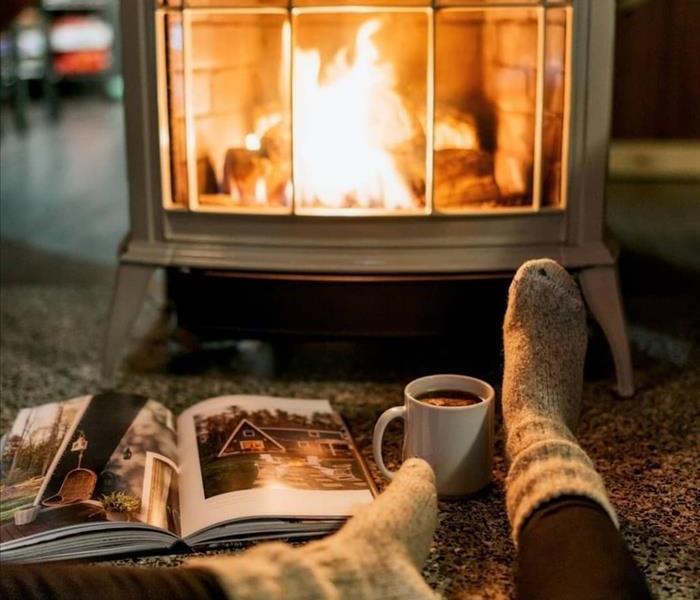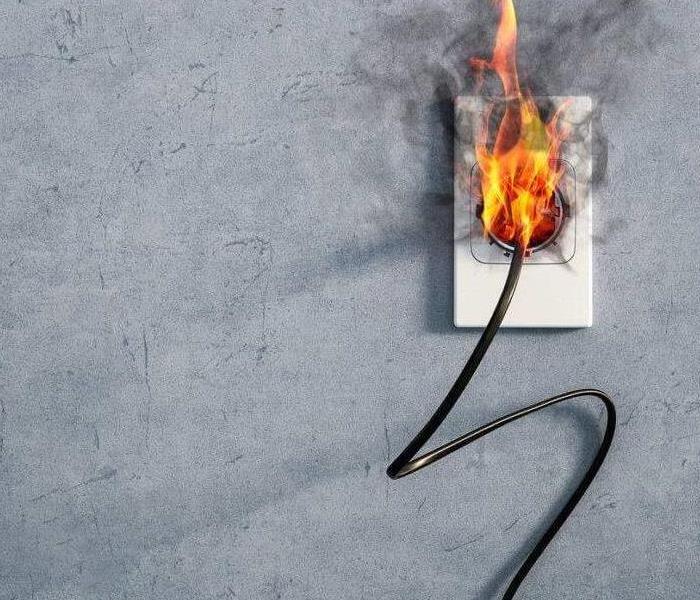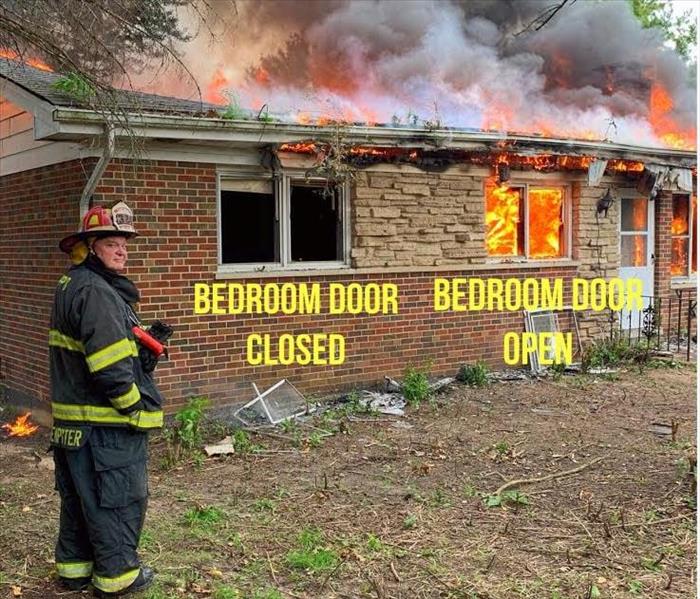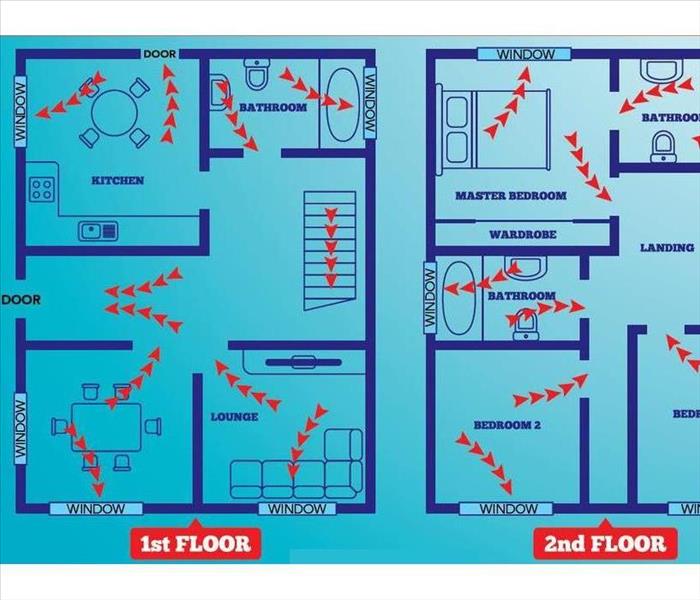Archived Fire Damage Blog Posts
The Impact of Smoke and Soot Damage
12/5/2024 (Permalink)
Smoke and soot can penetrate deep into your home, causing significant damage to your belongings and structure. Understanding the different types of smoke damage is crucial for effective restoration.
Types of Smoke Damage:
- Wet Smoke: Produced by smoldering fires, wet smoke is characterized by a pungent odor and sticky residue.
- Dry Smoke: High-temperature fires produce dry smoke, which can result in a powdery soot residue.
- Protein Fire Residue: This type of damage is caused by the evaporation of materials like plastics or rubber. It can be difficult to detect but can cause significant damage to surfaces.
SERVPRO®'s Comprehensive Fire Damage Restoration
Our team of experts is trained to identify and address the specific type of smoke damage your property has sustained. We use advanced cleaning techniques and equipment to remove soot and smoke odors, restoring your home to its preloss condition.
Our Fire Damage Restoration Services Include:
- Emergency Response: Prompt response to minimize damage.
- Water Damage Mitigation: Addressing water damage caused by fire suppression efforts.
- Smoke and Soot Removal: Thorough cleaning and sanitization of affected areas.
- Structural Repair: Repairing or replacing damaged structural elements.
- Content Cleaning and Restoration: Cleaning and restoring your belongings.
- Odor Removal: Eliminating lingering smoke odors.
Don't let fire damage disrupt your life. Contact SERVPRO of Elgin/Northwest Kane County today.
Are you prepared if your building has a fire?
10/11/2023 (Permalink)
Did you know that over 50% of businesses that have a major event such as a sever water damage or fire, never recover?! The loss of key customers due to delays in getting your operation back up and running could be the difference between success and never opening your doors again.
It is a scary thought.
Help your company by having SERVPRO® schedule an ERP inspection. Our Emergency Ready Program will help facility managers prepare for the unthinkable. We start by identifying important facility information, such as water shut offs, and critical areas of importance within the building. By doing this we can allow our emergency restoration professionals to concentrate their efforts on the areas that will provide you the flexibility to stay in operation and maintaining your important clients needs until the entire cleanup is completed.
A little planning today can provide a lot of reassurance in the future.
Contact us at 847.697.8500 to schedule an inspection.
Smoke and Soot Cleanup Fire
8/16/2023 (Permalink)
Smoke and soot is extremely invasive and can penetrate various cavities within your home, causing hidden damage and odor. Our smoke damage expertise and experience allows us to inspect and accurately assess the extent of the damage to develop a comprehensive plan of action.
Smoke and soot facts:
- Hot smoke migrates to cooler areas and upper levels of a structure.
- Smoke flows around plumbing systems, seeping through the holes used by pipes to go from floor to floor.
- The type of smoke may greatly affect the restoration process.
Different Types of Smoke
There are two different types of smoke–wet and dry. As a result, there are different types of soot residue after a fire. Before restoration begins, SERVPRO of Elgin/NW Kane County will test the soot to determine which type of smoke damage occurred. The cleaning procedures are then based on the information identified during pretesting. Here is some additional information:
Wet Smoke – Plastic and Rubber
- Low heat, smoldering, pungent odor, sticky, smeary. Smoke webs are more difficult to clean.
Dry Smoke – Paper and Wood
- Fast burning, high temperatures, heat rises therefore smoke rises.
Protein Fire Residue – Produced by evaporation of material rather than from a fire
- Virtually invisible, discolors paints and varnishes, extreme pungent odor.
Our Fire Damage Restoration Services
Since each smoke and fire damage situation is a different, each one requires a unique solution tailored for the specific conditions. We have the equipment, expertise, and experience to restore your fire and smoke damage. We will also treat your family with empathy and respect and your property with care.
Cozy up to fireplace safety in your Elgin Home
6/24/2022 (Permalink)
Fireplaces can add the ambiance of warmth and tranquility to your Elgin home on a chilly Sunday morning. It is important to remember if you don’t take care of your fireplace, your warmth and tranquility, it can quickly turn into a nightmare. And it can all start with the cleanliness of your chimney.
One of the best ways to prevent a disaster is to keep your fireplace clean. According to the National Fire Protection Association, 30% of heating fires are a result of unclean chimneys and equipment. This is due to a substance called creosote. Creosote is a byproduct of wood combustion that consists mainly of tar. Traces of this substance are found in the smoke that rises from open flames. When smoke is rising to the top of your chimney, it will mix with cold air and water to solidify and stick to the chimney liner. Creosote is not something that fixes itself either. It grows in a self-perpetuating cycle since it accumulates when there is lack of ventilation. This is a huge hazard because creosote is extremely flammable and can cause a destructive, deadly house fire.
Creosote forms naturally, so there is no way to completely avoid it while using your fireplace. Small amounts of presence of creosote is not the issues, it’s the buildup of this substance that is problematic. There are three stages of creosote buildup and here is how you can appropriately respond to each stage to get the best cleaning. When you decide it’s time to clean your chimney, ensure you use a trained professional.
- State One- A small amount of creosote is present and has a thin, flaky texture. At this stage, the coating can easily be brushed away by a technician using a specialized brush.
- Stage Two- A medium size amount of creosote is present which consents of more tar and soot. At this stage, it is a little tougher to remove the substance. To remove it, it would be most beneficial to use a rotary loop tool attached to a drill.
- Stage Three- A large amount of creosote is present which is very concentrated. It can feel either sticky and oily or hard and shiny depending if the coating is fresh. At this stage, it may actually be more cost-effective to simply replace the chimney liner than try to clean it.
Although there is no way to completely avoid creosote, you can take simple actions to slow the process of its buildup. Consider the following tips:
- Only use dry, seasoned wood in your chimney. This is wood that has been left to dry for at least 6 months
- Never burn artificial logs because they produce more combustion byproduct than regular wood
- Make sure your fire has an adequate amount of air
- Schedule an annual chimney cleaning and inspection
Unfortunately, sometimes disaster still happen despite taking the steps to prevent an accident. If your Elgin Home has experienced a fire due to creosote buildup, don’t feel you’re in this alone. We are the certified fire restoration experts and know how to bring your home back to preloss conditions. You can count on us to immediately assess the damages and begin the remediation and restoration process. For services or any questions, call our office (847) 697 8500.
Learn more about Elgin
Putting a Freeze on Winter Fires in the Elgin Area.
6/24/2022 (Permalink)
Did you know there are several hazards that increase the risk for a fire during the Elgin winters? People don’t think their Elgin home could be at risk for fires during the colder months, but there are many hazards that you need to watch out for in the winter. It’s important to be aware of each risk and how to avoid having a winter fire. The top two causes for fires during the winter are electrical and heating. Let’s going into further detail why these factors pose a fire risk and how you can stay fire-free this winter:
- Electrical
Electricity is the leading cause of home fires in the United States. Roughly half of all electrical home fire involve electrical distribution or lighting equipment. The top risks include faulty outlets, light fixtures, extension cords, and wiring. Many of these items do not seem dangerous, but according to the U.S. Fire Administration, 43% of the electrical fires were caused by a malfunction. Consider the following tips to avoid electrical fires and stay safe this winter season:
- Check electrical cords to make sure they are not running across doorways or under carpets where they can get damaged
- Have qualified electricians add more receptacle outlets in your home to reduce the use of extension cords
- Use light bulbs that match the recommended wattage on the lamp or fixture. The maximum wattage is located on the lamp’s sticker
- Keep electrical cords away from children and pets
- Heating
Heating is the second largest leading cause of United States home fires. December, January, and February are the peak months for heating fires. This is because we are trying to keep our Elgin homes warm during this time of year. Heating equipment includes wall furnaces, space heater, fireplace, and heat lamps. Most often, space heaters are the type of equipment involved in these types of fires. In fact, 86% of deaths from fires caused by heating are due to space heaters. Consider the following tips to avoid heating fires and how to stay safe this winter:
- Keep anything that burns at least 3 feet away from heating equipment
- Never use the oven to heat your home
- Have heating equipment and chimneys cleaned and professionally inspected every year
- Remember to turn portable heaters off when leaving the room or going to bed
- Always use the right kind of fuel, specified by the manufacturer, for fuel burning space heaters
SERVPRO of Elgin is your Elgin area fire restoration cleanup service. We are the certified technicians who can provide you peace of mind if a fire were to happen in your Elgin Home. You can always count on the fast response and the expertise of our SERVPRO of Elgin specialists to make you and your family feel “Like it never even happened.”
Learn more about Elgin
Cozy up to fireplace safety in your Elgin Home
3/11/2022 (Permalink)
 Cozy by the fireplace
Cozy by the fireplace
Fireplaces can add the ambiance of warmth and tranquility to your Elgin home on a chilly Sunday morning. It is important to remember if you don’t take care of your fireplace, your warmth and tranquility, it can quickly turn into a nightmare. And it can all start with the cleanliness of your chimney.
One of the best ways to prevent a disaster is to keep your fireplace clean. According to the National Fire Protection Association, 30% of heating fires are a result of unclean chimneys and equipment. This is due to a substance called creosote. Creosote is a byproduct of wood combustion that consists mainly of tar. Traces of this substance are found in the smoke that rises from open flames. When smoke is rising to the top of your chimney, it will mix with cold air and water to solidify and stick to the chimney liner. Creosote is not something that fixes itself either. It grows in a self-perpetuating cycle since it accumulates when there is lack of ventilation. This is a huge hazard because creosote is extremely flammable and can cause a destructive, deadly house fire.
Creosote forms naturally, so there is no way to completely avoid it while using your fireplace. Small amounts of presence of creosote is not the issues, it’s the buildup of this substance that is problematic. There are three stages of creosote buildup and here is how you can appropriately respond to each stage to get the best cleaning. When you decide it’s time to clean your chimney, ensure you use a trained professional.
- Stage One- A small amount of creosote is present and has a thin, flaky texture. At this stage, the coating can easily be brushed away by a technician using a specialized brush.
- Stage Two- A medium size amount of creosote is present which consents of more tar and soot. At this stage, it is a little tougher to remove the substance. To remove it, it would be most beneficial to use a rotary loop tool attached to a drill.
- Stage Three- A large amount of creosote is present which is very concentrated. It can feel either sticky and oily or hard and shiny depending if the coating is fresh. At this stage, it may actually be more cost-effective to simply replace the chimney liner than try to clean it.
Although there is no way to completely avoid creosote, you can take simple actions to slow the process of its buildup. Consider the following tips:
- Only use dry, seasoned wood in your chimney. This is wood that has been left to dry for at least 6 months
- Never burn artificial logs because they produce more combustion byproduct than regular wood
- Make sure your fire has an adequate amount of air
- Schedule an annual chimney cleaning and inspection
Unfortunately, sometimes disaster still happen despite taking the steps to prevent an accident. If your Elgin Home has experienced a fire due to creosote buildup, don’t feel you’re in this alone. We are the certified fire restoration experts and know how to bring your home back to preloss conditions. You can count on us to immediately assess the damages and begin the remediation and restoration process. For services or any questions, call our office (847) 697 8500.
Learn more about Elgin
Chimney fires can be prevented
3/11/2022 (Permalink)
 Keep your fireplace clean to prevent chimney fires
Keep your fireplace clean to prevent chimney fires
One of the best ways to prevent a disaster is to keep your fireplace clean. According to the National Fire Protection Association, 30% of heating fires are a result of unclean chimneys and equipment. This is due to a substance called creosote. Creosote is a byproduct of wood combustion that consists mainly of tar. Traces of this substance are found in the smoke that rises from open flames. When smoke is rising to the top of your chimney, it will mix with cold air and water to solidify and stick to the chimney liner. Creosote is not something that fixes itself either. It grows in a self-perpetuating cycle since it accumulates when there is lack of ventilation. This is a huge hazard because creosote is extremely flammable and can cause a destructive, deadly house fire.
Creosote forms naturally, so there is no way to completely avoid it while using your fireplace. Small amounts of presence of creosote is not the issues, it’s the buildup of this substance that is problematic. There are three stages of creosote buildup and here is how you can appropriately respond to each stage to get the best cleaning. When you decide it’s time to clean your chimney, ensure you use a trained professional.
- State One- A small amount of creosote is present and has a thin, flaky texture. At this stage, the coating can easily be brushed away by a technician using a specialized brush.
- Stage Two- A medium size amount of creosote is present which consents of more tar and soot. At this stage, it is a little tougher to remove the substance. To remove it, it would be most beneficial to use a rotary loop tool attached to a drill.
- Stage Three- A large amount of creosote is present which is very concentrated. It can feel either sticky and oily or hard and shiny depending if the coating is fresh. At this stage, it may actually be more cost-effective to simply replace the chimney liner than try to clean it.
Although there is no way to completely avoid creosote, you can take simple actions to slow the process of its buildup. Consider the following tips:
- Only use dry, seasoned wood in your chimney. This is wood that has been left to dry for at least 6 months
- Never burn artificial logs because they produce more combustion byproduct than regular wood
- Make sure your fire has an adequate amount of air
- Schedule an annual chimney cleaning and inspection
Unfortunately, sometimes disaster still happen despite taking the steps to prevent an accident. If your Elgin Home has experienced a fire due to creosote buildup, don’t feel you’re in this alone. We are the certified fire restoration experts and know how to bring your home back to preloss conditions. You can count on us to immediately assess the damages and begin the remediation and restoration process. For services or any questions, call our office (847) 697 8500.
Learn more about Elgin
Fires before the paint even dries
1/11/2022 (Permalink)
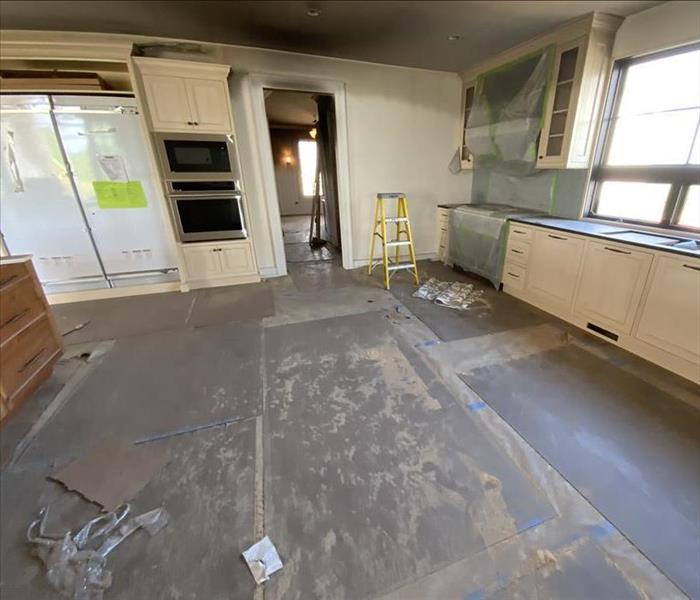 Smoke on unfinished trim wood
Smoke on unfinished trim wood
You are enjoying the opportunity to design your own home. Picking the cabinets, colors, lights, fixtures, absolutely everything. As the deliveries are made, you can see the unmistakable progress marching on to completion. The biggest issue is, will we get done and moved in before _______. You fill in the blank.
In your wildest nightmare you never imagined, what if we have a fire? What will need to be replaced, or reordered? What is salvageable? Can the mitigation vendor work with our construction team to try and keep the overall project moving? But these accidents do happen. Maybe due to an electrical issue. Maybe due to a careless placement of a cigarette or the placing of numerous wood staining rags into a pipe that spontaneously combusts into a fire.
These fires can be even more difficult due to the unfinished and unpainted surfaces absorbing smoke smells and combustion residue.
A careful review of all surfaces needs to be performed to determine what can be cleaned, what can be encapsulated, and unfortunately what will need to be replaced. It can be sad to have to replace brand new items that were never used before. But our job is to get the structure back to "preloss" condition, how ever that needs to be done.
Cozy up to fireplace Safety
11/12/2021 (Permalink)
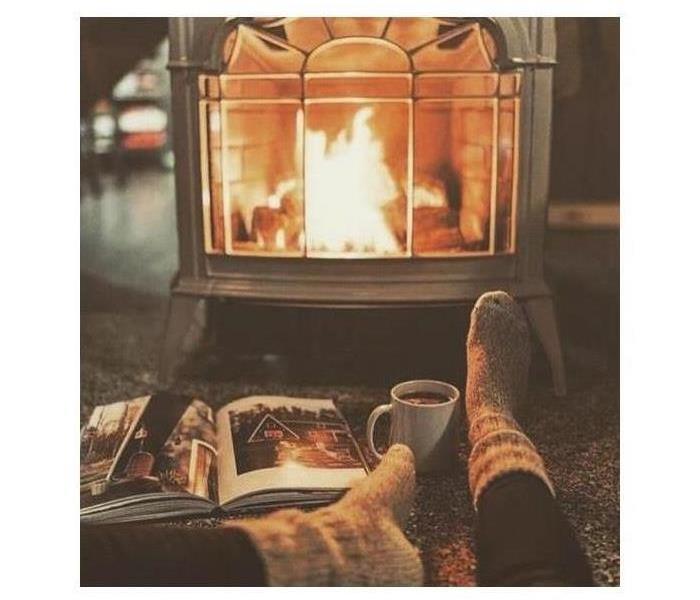 Keep your fireplace in good working order
Keep your fireplace in good working order
Fireplaces can add the ambiance of warmth and tranquility to your Elgin home on a chilly Sunday morning. It is important to remember if you don’t take care of your fireplace, your warmth and tranquility, it can quickly turn into a nightmare. And it can all start with the cleanliness of your chimney.
One of the best ways to prevent a disaster is to keep your fireplace clean. According to the National Fire Protection Association, 30% of heating fires are a result of unclean chimneys and equipment. This is due to a substance called creosote. Creosote is a byproduct of wood combustion that consists mainly of tar. Traces of this substance are found in the smoke that rises from open flames. When smoke is rising to the top of your chimney, it will mix with cold air and water to solidify and stick to the chimney liner. Creosote is not something that fixes itself either. It grows in a self-perpetuating cycle since it accumulates when there is lack of ventilation. This is a huge hazard because creosote is extremely flammable and can cause a destructive, deadly house fire.
Creosote forms naturally, so there is no way to completely avoid it while using your fireplace. Small amounts of presence of creosote is not the issues, it’s the buildup of this substance that is problematic. There are three stages of creosote buildup and here is how you can appropriately respond to each stage to get the best cleaning. When you decide it’s time to clean your chimney, ensure you use a trained professional.
- Stage One- A small amount of creosote is present and has a thin, flaky texture. At this stage, the coating can easily be brushed away by a technician using a specialized brush.
- Stage Two- A medium size amount of creosote is present which consents of more tar and soot. At this stage, it is a little tougher to remove the substance. To remove it, it would be most beneficial to use a rotary loop tool attached to a drill.
- Stage Three- A large amount of creosote is present which is very concentrated. It can feel either sticky and oily or hard and shiny depending if the coating is fresh. At this stage, it may actually be more cost-effective to simply replace the chimney liner than try to clean it.
Although there is no way to completely avoid creosote, you can take simple actions to slow the process of its buildup. Consider the following tips:
- Only use dry, seasoned wood in your chimney. This is wood that has been left to dry for at least 6 months
- Never burn artificial logs because they produce more combustion byproduct than regular wood
- Make sure your fire has an adequate amount of air
- Schedule an annual chimney cleaning and inspection
Unfortunately, sometimes disaster still happen despite taking the steps to prevent an accident. If your Elgin Home has experienced a fire due to creosote buildup, don’t feel you’re in this alone. We are the certified fire restoration experts and know how to bring your home back to preloss conditions. You can count on us to immediately assess the damages and begin the remediation and restoration process. For services or any questions, call our office (847) 697 8500.
Learn more about Elgin
Keep your home safe from fires this winter
11/12/2021 (Permalink)
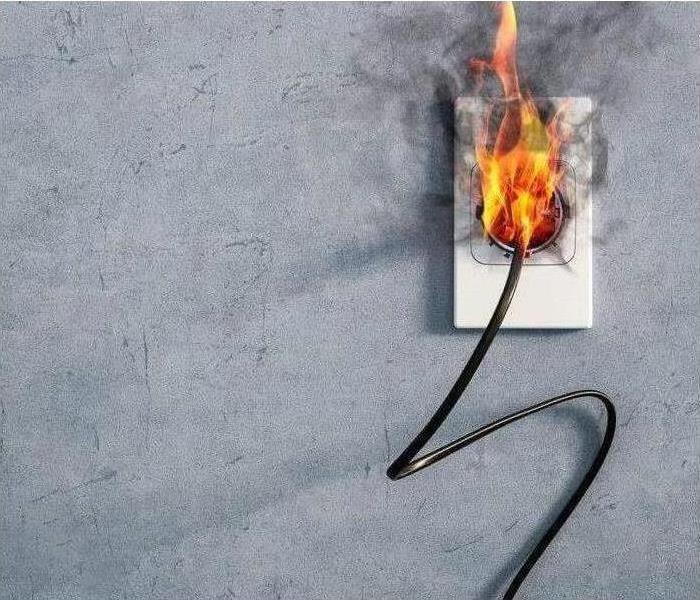 Electrical outlet fire
Electrical outlet fire
Did you know there are several hazards that increase the risk for a fire during the Elgin winters? People don’t think their Elgin home could be at risk for fires during the colder months, but there are many hazards that you need to watch out for in the winter. It’s important to be aware of each risk and how to avoid having a winter fire. The top two causes for fires during the winter are electrical and heating. Let’s going into further detail why these factors pose a fire risk and how you can stay fire-free this winter:
- Electrical
Electricity is the leading cause of home fires in the United States. Roughly half of all electrical home fire involve electrical distribution or lighting equipment. The top risks include faulty outlets, light fixtures, extension cords, and wiring. Many of these items do not seem dangerous, but according to the U.S. Fire Administration, 43% of the electrical fires were caused by a malfunction. Consider the following tips to avoid electrical fires and stay safe this winter season:
- Check electrical cords to make sure they are not running across doorways or under carpets where they can get damaged
- Have qualified electricians add more receptacle outlets in your home to reduce the use of extension cords
- Use light bulbs that match the recommended wattage on the lamp or fixture. The maximum wattage is located on the lamp’s sticker
- Keep electrical cords away from children and pets
- Heating
Heating is the second largest leading cause of United States home fires. December, January, and February are the peak months for heating fires. This is because we are trying to keep our Elgin homes warm during this time of year. Heating equipment includes wall furnaces, space heater, fireplace, and heat lamps. Most often, space heaters are the type of equipment involved in these types of fires. In fact, 86% of deaths from fires caused by heating are due to space heaters. Consider the following tips to avoid heating fires and how to stay safe this winter:
- Keep anything that burns at least 3 feet away from heating equipment
- Never use the oven to heat your home
- Have heating equipment and chimneys cleaned and professionally inspected every year
- Remember to turn portable heaters off when leaving the room or going to bed
- Always use the right kind of fuel, specified by the manufacturer, for fuel burning space heaters
SERVPRO of Elgin is your Elgin area fire restoration cleanup service. We are the certified technicians who can provide you peace of mind if a fire were to happen in your Elgin Home. You can always count on the fast response and the expertise of our SERVPRO of Elgin specialists to make you and your family feel “Like it never even happened.”
Learn more about Elgin
Safety tip from your firefighters: "Close Before You Doze!"
11/5/2021 (Permalink)
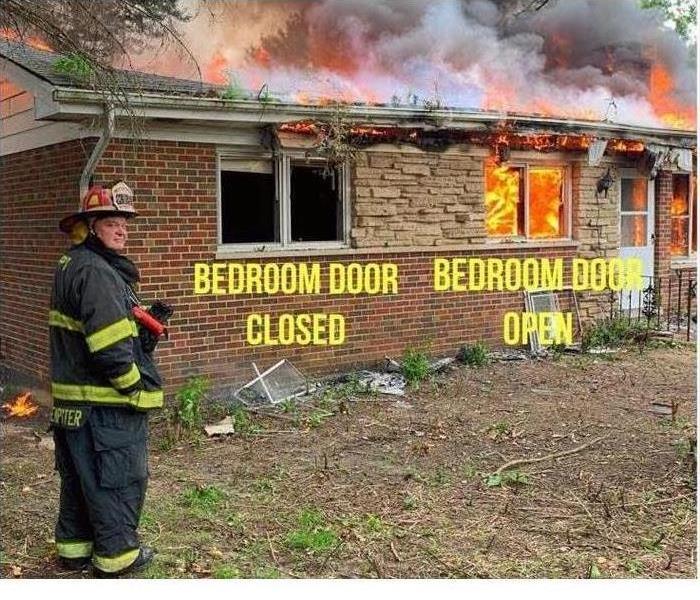 Keep doors closed when you sleep
Keep doors closed when you sleep
Close Before You Doze is a public fire safety campaign promoted by The UL Firefighter Safety Research. It has been proven during a fire, a closed door can make the difference between 100 degrees and 1,000 degrees. This significant difference has promoted the habit of sleeping with doors closed. It can help add critical time to your escape if a fire were to happen.
This is especially important with the “evolving fire environment”, caused by the increase use of synthetics in modern homes. Forty years ago, the average time needed to escape a burning home was seventeen minutes. Today, the evolving fire environment has caused it to drop to only three minutes. The change in construction materials, furnishings and open layouts, has caused drastic reduction time. These factors allow the fire to spread and become more toxic much quicker.
It is common for people to want to leave the door open whether they have kids or do not think a door can make a significant difference. In fact, only 29% of people always sleep with their door closed. Therefore, it is very important for families to understand the lifesaving difference a closed door will make. A fire needs heat, fuel, and oxygen to grow. So, when a door is closed, it limits the fire’s resources to spread. Furthermore, when a door is closed, not as much carbon monoxide will enter the room. This will keep the oxygen at a breathable level for additional time. The reduction of toxic smoke, improved oxygen levels, and decreased room temperatures will give you more time to escape the fire just by simply closing your door.
Closing the door when you go to sleep is one thing, but if there is an actual fire, it is critical to know the next steps of determining if the door is safe to open. First, you should look for smoke coming through the cracks in the door. If there is smoke, do not open the door. Next, gently touch the door to see if it is hot. If it is hot, do not open the door. Checking the door should be part of your escape plan. Make sure your family has established and rehearsed a plan to exit a burning fire.
Home Escape Plans can Save Lives
11/5/2021 (Permalink)
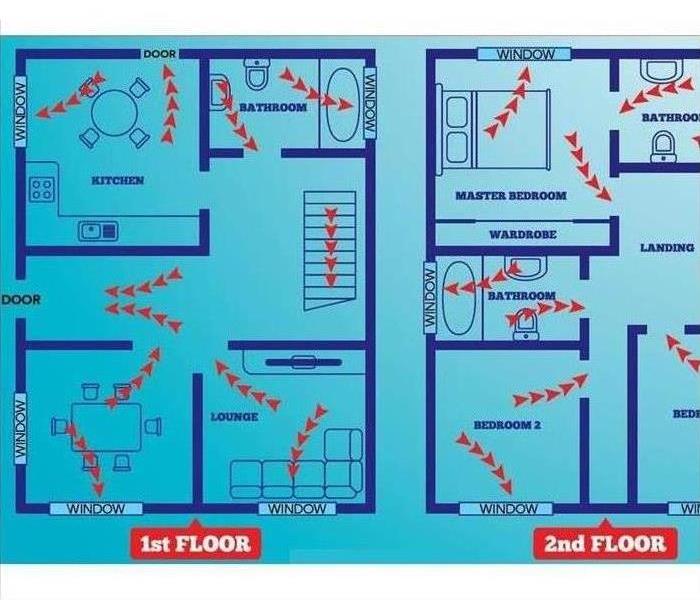 Plan to get out of your house in a fire
Plan to get out of your house in a fire
In the past 40 years, time available for escaping from a fire has dropped from 17 minutes to less than 3 minutes due to the evolution of materials in modern homes. This makes it vital to create and practice an emergency escape plan. Home fires are the single most common disaster across the nation, but only 26% of Americans have developed an escape plan for a fire.
When developing your plan, here are a few suggestions:
- Draw a map of each level in your home. Locate all the doors, windows, and identify two ways to exit each room.
- Consider a collapsible escape ladder for your second and third floors. You should only buy them from a recognized testing laboratory.
- Choose an outside meeting place. It should be in front of your home, but also a safe distance away from the fire.
- Some examples include: Neighbor’s house, light post, mailbox, or stop sign.
- If your doors or windows have security bars, make sure the bars have emergency release devices inside so they can be opened immediately.
- Emergency release devices do not compromise your security
- Teach children how to escape on their own in case you cannot help them.
Pets are a part of your family too. Half of a million pets are affected by home fires each year. Here are a few tips to creating an escape plan for your animal(s):
- Pets will be afraid. Put your dog on a leash and keep your cat in a carrier. This will secure them with you and prevent them from fleeing.
- Identify your pet’s favorite hiding place ahead of time, as this is where they will most likely be hiding if a fire starts.
- Post “pet rescue stickers” to a front window, in an easy-to-spot location. The decal includes number of pets in your home, so rescuers know who to look for when entering.
When you are not home, contain them near an exit. It will provide a better chance of firefighters finding your animal.
Fall is a beautiful season, but it does have risks
11/5/2021 (Permalink)
 Take care with your holiday decorations
Take care with your holiday decorations
The leaves are falling, the temperature is dropping, and the holiday season is fast approaching. With Thanksgiving around the corner and Christmas right behind it, there is no shortage of holiday spirit around this time of year. Everyone loves displaying their cornucopia, dried cornstalks and scented candles. These are all classic hallmarks of the fall holidays, but they can also be very dangerous. Decorations are the cause of 800 reported fires each year. Here are a few tips to keep your decorations from going up in flames:
- Use battery powered lights instead of candles
- Do not leave candles unattended or lit while you sleep
- Keep flammable décor like dried flowers, cornstalk, and crepe paper away from open flames
- Verify that all holiday lights and extension cords have been tested by an organization such as Factory Mutual or Underwriters Laboratory
Fall is also filled with many activities. From apple picking to corn mazes, fall has some of the most fun activities, but some of them can also pose a fire risk. For examples, bonfires are perfect for roasting marshmallows or gathering around on a chilly night, but there needs to be cautionary steps when handling them:
- Set your bonfire up at least 25 feet away from structures
- Never use gasoline, kerosene, or any other flammable liquid to start a fire
- Use a match or lighter to ignite tinder
- Keep the fire small and controlled. Never leave it unattended
- Keep a hose, bucket of water, or sand nearby to extinguish the fire once you’re finished
- Read more about Elgin’s rules on open fires here
Cozy up to fireplace safety in Elgin
3/20/2021 (Permalink)
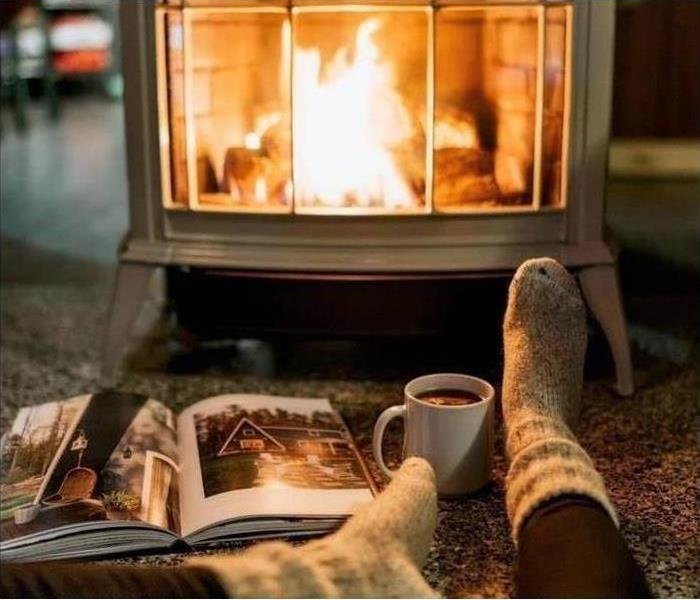 Nice and cozy. keep it that way!!
Nice and cozy. keep it that way!!
Fireplaces can add the ambiance of warmth and tranquility to your Elgin home on a chilly Sunday morning. It is important to remember if you don’t take care of your fireplace, your warmth and tranquility, it can quickly turn into a nightmare. And it can all start with the cleanliness of your chimney.
One of the best ways to prevent a disaster is to keep your fireplace clean. According to the National Fire Protection Association, 30% of heating fires are a result of unclean chimneys and equipment. This is due to a substance called creosote. Creosote is a byproduct of wood combustion that consists mainly of tar. Traces of this substance are found in the smoke that rises from open flames. When smoke is rising to the top of your chimney, it will mix with cold air and water to solidify and stick to the chimney liner. Creosote is not something that fixes itself either. It grows in a self-perpetuating cycle since it accumulates when there is lack of ventilation. This is a huge hazard because creosote is extremely flammable and can cause a destructive, deadly house fire.
Creosote forms naturally, so there is no way to completely avoid it while using your fireplace. Small amounts of presence of creosote is not the issues, it’s the buildup of this substance that is problematic. There are three stages of creosote buildup and here is how you can appropriately respond to each stage to get the best cleaning. When you decide it’s time to clean your chimney, ensure you use a trained professional.
- Stage One- A small amount of creosote is present and has a thin, flaky texture. At this stage, the coating can easily be brushed away by a technician using a specialized brush.
- Stage Two- A medium size amount of creosote is present which consents of more tar and soot. At this stage, it is a little tougher to remove the substance. To remove it, it would be most beneficial to use a rotary loop tool attached to a drill.
- Stage Three- A large amount of creosote is present which is very concentrated. It can feel either sticky and oily or hard and shiny depending if the coating is fresh. At this stage, it may actually be more cost-effective to simply replace the chimney liner than try to clean it.
Although there is no way to completely avoid creosote, you can take simple actions to slow the process of its buildup. Consider the following tips:
- Only use dry, seasoned wood in your chimney. This is wood that has been left to dry for at least 6 months
- Never burn artificial logs because they produce more combustion byproduct than regular wood
- Make sure your fire has an adequate amount of air
- Schedule an annual chimney cleaning and inspection
Unfortunately, sometimes disaster still happen despite taking the steps to prevent an accident. If your Elgin Home has experienced a fire due to creosote buildup, don’t feel you’re in this alone. We are the certified fire restoration experts and know how to bring your home back to preloss conditions. You can count on us to immediately assess the damages and begin the remediation and restoration process. For services or any questions, call our office (847) 697 8500.
Learn more about Elgin
Cozy Up to Fireplace Safety in Elgin
3/12/2021 (Permalink)
Fireplaces can add the ambiance of warmth and tranquility to your Elgin home on a chilly Sunday morning. It is important to remember if you don’t take care of your fireplace, your warmth and tranquility, it can quickly turn into a nightmare. And it can all start with the cleanliness of your chimney.
One of the best ways to prevent a disaster is to keep your fireplace clean. According to the National Fire Protection Association, 30% of heating fires are a result of unclean chimneys and equipment. This is due to a substance called creosote. Creosote is a byproduct of wood combustion that consists mainly of tar. Traces of this substance are found in the smoke that rises from open flames. When smoke is rising to the top of your chimney, it will mix with cold air and water to solidify and stick to the chimney liner. Creosote is not something that fixes itself either. It grows in a self-perpetuating cycle since it accumulates when there is lack of ventilation. This is a huge hazard because creosote is extremely flammable and can cause a destructive, deadly house fire.
Creosote forms naturally, so there is no way to completely avoid it while using your fireplace. Small amounts of presence of creosote is not the issues, it’s the buildup of this substance that is problematic. There are three stages of creosote buildup and here is how you can appropriately respond to each stage to get the best cleaning. When you decide it’s time to clean your chimney, ensure you use a trained professional.
- State One- A small amount of creosote is present and has a thin, flaky texture. At this stage, the coating can easily be brushed away by a technician using a specialized brush.
- Stage Two- A medium size amount of creosote is present which consents of more tar and soot. At this stage, it is a little tougher to remove the substance. To remove it, it would be most beneficial to use a rotary loop tool attached to a drill.
- Stage Three- A large amount of creosote is present which is very concentrated. It can feel either sticky and oily or hard and shiny depending if the coating is fresh. At this stage, it may actually be more cost-effective to simply replace the chimney liner than try to clean it.
Although there is no way to completely avoid creosote, you can take simple actions to slow the process of its buildup. Consider the following tips:
- Only use dry, seasoned wood in your chimney. This is wood that has been left to dry for at least 6 months
- Never burn artificial logs because they produce more combustion byproduct than regular wood
- Make sure your fire has an adequate amount of air
- Schedule an annual chimney cleaning and inspection
Unfortunately, sometimes disaster still happen despite taking the steps to prevent an accident. If your Elgin Home has experienced a fire due to creosote buildup, don’t feel you’re in this alone. We are the certified fire restoration experts and know how to bring your home back to preloss conditions. You can count on us to immediately assess the damages and begin the remediation and restoration process. For services or any questions, call our office (847) 697 8500.
Learn more about Elgin
Put a Freeze on Winter Fires in Elgin
1/25/2021 (Permalink)
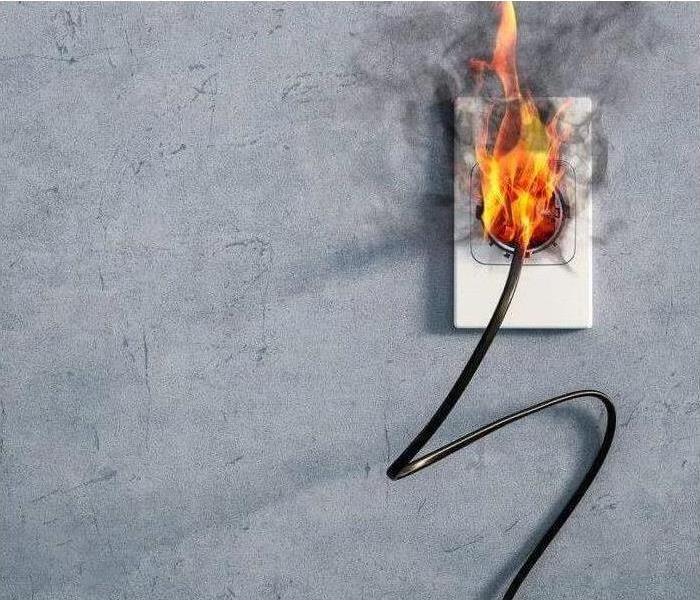 Electrical issues are the leading cause of house fires
Electrical issues are the leading cause of house fires
Did you know there are several hazards that increase the risk for a fire during the Elgin winters? People don’t think their Elgin home could be at risk for fires during the colder months, but there are many hazards that you need to watch out for in the winter. It’s important to be aware of each risk and how to avoid having a winter fire. The top two causes for fires during the winter are electrical and heating. Let’s going into further detail why these factors pose a fire risk and how you can stay fire-free this winter:
- Electrical
Electricity is the leading cause of home fires in the United States. Roughly half of all electrical home fire involve electrical distribution or lighting equipment. The top risks include faulty outlets, light fixtures, extension cords, and wiring. Many of these items do not seem dangerous, but according to the U.S. Fire Administration, 43% of the electrical fires were caused by a malfunction. Consider the following tips to avoid electrical fires and stay safe this winter season:
- Check electrical cords to make sure they are not running across doorways or under carpets where they can get damaged
- Have qualified electricians add more receptacle outlets in your home to reduce the use of extension cords
- Use light bulbs that match the recommended wattage on the lamp or fixture. The maximum wattage is located on the lamp’s sticker
- Keep electrical cords away from children and pets
- Heating
Heating is the second largest leading cause of United States home fires. December, January, and February are the peak months for heating fires. This is because we are trying to keep our Elgin homes warm during this time of year. Heating equipment includes wall furnaces, space heater, fireplace, and heat lamps. Most often, space heaters are the type of equipment involved in these types of fires. In fact, 86% of deaths from fires caused by heating are due to space heaters. Consider the following tips to avoid heating fires and how to stay safe this winter:
- Keep anything that burns at least 3 feet away from heating equipment
- Never use the oven to heat your home
- Have heating equipment and chimneys cleaned and professionally inspected every year
- Remember to turn portable heaters off when leaving the room or going to bed
- Always use the right kind of fuel, specified by the manufacturer, for fuel burning space heaters
SERVPRO of Elgin is your Elgin area fire restoration cleanup service. We are the certified technicians who can provide you peace of mind if a fire were to happen in your Elgin Home. You can always count on the fast response and the expertise of our SERVPRO of Elgin specialists to make you and your family feel “Like it never even happened.”
Learn more about Elgin
Close Before You Doze: Life Saving Habit For Your Elgin Home
11/12/2020 (Permalink)
Close Before You Doze is a public fire safety campaign promoted by The UL Firefighter Safety Research. It has been proven during a fire, a closed door can make the difference between 100 degrees and 1,000 degrees. This significant difference has promoted the habit of sleeping with doors closed. It can help add critical time to your escape if a fire were to happen.
This is especially important with the “evolving fire environment”, caused by the increase use of synthetics in modern homes. Forty years ago, the average time needed to escape a burning home was seventeen minutes. Today, the evolving fire environment has caused it to drop to only three minutes. The change in construction materials, furnishings and open layouts, has caused drastic reduction time. These factors allow the fire to spread and become more toxic much quicker.
It is common for people to want to leave the door open whether they have kids or do not think a door can make a significant difference. In fact, only 29% of people always sleep with their door closed. Therefore, it is very important for families to understand the lifesaving difference a closed door will make. A fire needs heat, fuel, and oxygen to grow. So, when a door is closed, it limits the fire’s resources to spread. Furthermore, when a door is closed, not as much carbon monoxide will enter the room. This will keep the oxygen at a breathable level for additional time. The reduction of toxic smoke, improved oxygen levels, and decreased room temperatures will give you more time to escape the fire just by simply closing your door.
Closing the door when you go to sleep is one thing, but if there is an actual fire, it is critical to know the next steps of determining if the door is safe to open. First, you should look for smoke coming through the cracks in the door. If there is smoke, do not open the door. Next, gently touch the door to see if it is hot. If it is hot, do not open the door. Checking the door should be part of your escape plan. Make sure your family has established and rehearsed a plan to exit a burning fire.
Make an Escape Plan For Your Elgin Home
11/12/2020 (Permalink)
In the past 40 years, escaping from a fire has dropped from 17 minutes to less than 3 minutes due to the evolution of materials in modern homes. This makes it vital to create and practice an emergency escape plan. Home fires are the single most common disaster across the nation, but only 26% of Americans have developed an escape plan for a fire.
When developing your plan, here are a few suggestions:
- Draw a map of each level in your home. Locate all the doors, windows, and identify two ways to exit each room.
- Consider a collapsible escape ladder for your second and third floors. You should only buy them from a recognized testing laboratory.
- Choose an outside meeting place. It should be in front of your home, but also a safe distance away from the fire.
- Some examples include: Neighbor’s house, light post, mailbox, or stop sign.
- If your doors or windows have security bars, make sure the bars have emergency release devices inside so they can be opened immediately.
- Emergency release devices do not compromise your security
- Teach children how to escape on their own in case you cannot help them.
Pets are a part of your family too. Half of a million pets are affected by home fires each year. Here are a few tips to creating an escape plan for your animal(s):
- Pets will be afraid. Put your dog on a leash and keep your cat in a carrier. This will secure them with you and prevent them from fleeing.
- Identify your pet’s favorite hiding place ahead of time, as this is where they will most likely be hiding if a fire starts.
- Post “pet rescue stickers” to a front window, in an easy-to-spot location. The decal includes number of pets in your home, so rescuers know who to look for when entering.
When you are not home, contain them near an exit. It will provide a better chance of firefighters finding your animal.
Don’t Fall for These Autumn Fire Risks
11/12/2020 (Permalink)
The leaves are falling, the temperature is dropping, and the holiday season is fast approaching. With Thanksgiving around the corner and Christmas right behind it, there is no shortage of holiday spirit around this time of year. Everyone loves displaying their cornucopia, dried cornstalks and scented candles. These are all classic hallmarks of the fall holidays, but they can also be very dangerous. Decorations are the cause of 800 reported fires each year. Here are a few tips to keep your decorations from going up in flames:
- Use battery powered lights instead of candles
- Do not leave candles unattended or lit while you sleep
- Keep flammable décor like dried flowers, cornstalk, and crepe paper away from open flames
- Verify that all holiday lights and extension cords have been tested by an organization such as Factory Mutual or Underwriters Laboratory
Fall is also filled with many activities. From apple picking to corn mazes, fall has some of the most fun activities, but some of them can also pose a fire risk. For examples, bonfires are perfect for roasting marshmallows or gathering around on a chilly night, but there needs to be cautionary steps when handling them:
- Set your bonfire up at least 25 feet away from structures
- Never use gasoline, kerosene, or any other flammable liquid to start a fire
- Use a match or lighter to ignite tinder
- Keep the fire small and controlled. Never leave it unattended
- Keep a hose, bucket of water, or sand nearby to extinguish the fire once you’re finished
- Read more about Elgin’s rules on open fires here
Soot Safety After a Fire in Elgin
5/18/2020 (Permalink)
Picture this: An accidental fire has started in your beautiful Elgin home and you’re forced to quickly evacuate. Through the chaos and uncertainty, you and your loved ones have safely exited the home and are now a good distance away from the scorching flames. Everyone is now waiting outside as the rescue team fights to extinguish the fire. The firefighters were able to extinguish the flames and saved your home from burning down. They have determined your home is structurally sound enough for you to go back inside, but is your home really safe again?
As if dealing with a house fire was not enough, once the initial danger has passed, you have to deal with soot which has spread throughout your home. Soot is made of tiny carbon particles created by incomplete combustion of fossil fuels. It contains a lot of hazardous materials which give off an ugly sight and foul smell. This can be quite harmful to you and your family and may cause health effects.
Soot exposure is a serious matter and it’s vital to ensure the soot-affected area has been properly cleaned by professionals. Statistics from a 2017 study, in JAMA, show that particle exposure leads to around 20,000 deaths in the United States each year. In fact, soot related diseases are the culprit of many of them. It has been the main cause of 300,000 asthma attack and two million lost workdays. Don’t let your home fire and its soot particles become one of these statistics.
Although safety risks from fires do not end once the flames are out, there are ways you can still bring your Elgin home back to a safe environment. SERVPRO of Elgin is here to offer the fire restoration services your home needs after a horrendous disaster. We are the trained professionals and know how to properly bring your home back to preloss conditions. Feel free to call us with any questions or schedule your services (847) 697-8500. Also consider reading more about an Emergency Escape Plan to prepare for this kind of disaster.
Learn more about Elgin.
Cozy Up to Fireplace Safety in Elgin
3/5/2020 (Permalink)
Fireplaces can add the ambiance of warmth and tranquility to your Elgin home on a chilly Sunday morning. It is important to remember if you don’t take care of your fireplace, your warmth and tranquility, it can quickly turn into a nightmare. And it can all start with the cleanliness of your chimney.
One of the best ways to prevent a disaster is to keep your fireplace clean. According to the National Fire Protection Association, 30% of heating fires are a result of unclean chimneys and equipment. This is due to a substance called creosote. Creosote is a byproduct of wood combustion that consists mainly of tar. Traces of this substance are found in the smoke that rises from open flames. When smoke is rising to the top of your chimney, it will mix with cold air and water to solidify and stick to the chimney liner. Creosote is not something that fixes itself either. It grows in a self-perpetuating cycle since it accumulates when there is lack of ventilation. This is a huge hazard because creosote is extremely flammable and can cause a destructive, deadly house fire.
Creosote forms naturally, so there is no way to completely avoid it while using your fireplace. Small amounts of presence of creosote is not the issues, it’s the buildup of this substance that is problematic. There are three stages of creosote buildup and here is how you can appropriately respond to each stage to get the best cleaning. When you decide it’s time to clean your chimney, ensure you use a trained professional.
- State One- A small amount of creosote is present and has a thin, flaky texture. At this stage, the coating can easily be brushed away by a technician using a specialized brush.
- Stage Two- A medium size amount of creosote is present which consents of more tar and soot. At this stage, it is a little tougher to remove the substance. To remove it, it would be most beneficial to use a rotary loop tool attached to a drill.
- Stage Three- A large amount of creosote is present which is very concentrated. It can feel either sticky and oily or hard and shiny depending if the coating is fresh. At this stage, it may actually be more cost-effective to simply replace the chimney liner than try to clean it.
Although there is no way to completely avoid creosote, you can take simple actions to slow the process of its buildup. Consider the following tips:
- Only use dry, seasoned wood in your chimney. This is wood that has been left to dry for at least 6 months
- Never burn artificial logs because they produce more combustion byproduct than regular wood
- Make sure your fire has an adequate amount of air
- Schedule an annual chimney cleaning and inspection
Unfortunately, sometimes disaster still happen despite taking the steps to prevent an accident. If your Elgin Home has experienced a fire due to creosote buildup, don’t feel you’re in this alone. We are the certified fire restoration experts and know how to bring your home back to preloss conditions. You can count on us to immediately assess the damages and begin the remediation and restoration process. For services or any questions, call our office (847) 697 8500.
Learn more about Elgin
Put a Freeze on Winter Fires in Elgin
1/21/2020 (Permalink)
Did you know there are several hazards that increase the risk for a fire during the Elgin winters? People don’t think their Elgin home could be at risk for fires during the colder months, but there are many hazards that you need to watch out for in the winter. It’s important to be aware of each risk and how to avoid having a winter fire. The top two causes for fires during the winter are electrical and heating. Let’s going into further detail why these factors pose a fire risk and how you can stay fire-free this winter:
- Electrical
Electricity is the leading cause of home fires in the United States. Roughly half of all electrical home fire involve electrical distribution or lighting equipment. The top risks include faulty outlets, light fixtures, extension cords, and wiring. Many of these items do not seem dangerous, but according to the U.S. Fire Administration, 43% of the electrical fires were caused by a malfunction. Consider the following tips to avoid electrical fires and stay safe this winter season:
- Check electrical cords to make sure they are not running across doorways or under carpets where they can get damaged
- Have qualified electricians add more receptacle outlets in your home to reduce the use of extension cords
- Use light bulbs that match the recommended wattage on the lamp or fixture. The maximum wattage is located on the lamp’s sticker
- Keep electrical cords away from children and pets
- Heating
Heating is the second largest leading cause of United States home fires. December, January, and February are the peak months for heating fires. This is because we are trying to keep our Elgin homes warm during this time of year. Heating equipment includes wall furnaces, space heater, fireplace, and heat lamps. Most often, space heaters are the type of equipment involved in these types of fires. In fact, 86% of deaths from fires caused by heating are due to space heaters. Consider the following tips to avoid heating fires and how to stay safe this winter:
- Keep anything that burns at least 3 feet away from heating equipment
- Never use the oven to heat your home
- Have heating equipment and chimneys cleaned and professionally inspected every year
- Remember to turn portable heaters off when leaving the room or going to bed
- Always use the right kind of fuel, specified by the manufacturer, for fuel burning space heaters
SERVPRO of Elgin is your Elgin area fire restoration cleanup service. We are the certified technicians who can provide you peace of mind if a fire were to happen in your Elgin Home. You can always count on the fast response and the expertise of our SERVPRO of Elgin specialists to make you and your family feel “Like it never even happened.”
Learn more about Elgin
Close Before You Doze: Life Saving Habit For Your Elgin Home
11/20/2019 (Permalink)
Close Before You Doze is a public fire safety campaign promoted by The UL Firefighter Safety Research. It has been proven during a fire, a closed door can make the difference between 100 degrees and 1,000 degrees. This significant difference has promoted the habit of sleeping with doors closed. It can help add critical time to your escape if a fire were to happen.
This is especially important with the “evolving fire environment”, caused by the increase use of synthetics in modern homes. Forty years ago, the average time needed to escape a burning home was seventeen minutes. Today, the evolving fire environment has caused it to drop to only three minutes. The change in construction materials, furnishings and open layouts, has caused drastic reduction time. These factors allow the fire to spread and become more toxic much quicker.
It is common for people to want to leave the door open whether they have kids or do not think a door can make a significant difference. In fact, only 29% of people always sleep with their door closed. Therefore, it is very important for families to understand the lifesaving difference a closed door will make. A fire needs heat, fuel, and oxygen to grow. So, when a door is closed, it limits the fire’s resources to spread. Furthermore, when a door is closed, not as much carbon monoxide will enter the room. This will keep the oxygen at a breathable level for additional time. The reduction of toxic smoke, improved oxygen levels, and decreased room temperatures will give you more time to escape the fire just by simply closing your door.
Closing the door when you go to sleep is one thing, but if there is an actual fire, it is critical to know the next steps of determining if the door is safe to open. First, you should look for smoke coming through the cracks in the door. If there is smoke, do not open the door. Next, gently touch the door to see if it is hot. If it is hot, do not open the door. Checking the door should be part of your escape plan. Make sure your family has established and rehearsed a plan to exit a burning fire.
Make an Escape Plan For Your Elgin Home
11/20/2019 (Permalink)
In the past 40 years, escaping from a fire has dropped from 17 minutes to less than 3 minutes due to the evolution of materials in modern homes. This makes it vital to create and practice an emergency escape plan. Home fires are the single most common disaster across the nation, but only 26% of Americans have developed an escape plan for a fire.
When developing your plan, here are a few suggestions:
- Draw a map of each level in your home. Locate all the doors, windows, and identify two ways to exit each room.
- Consider a collapsible escape ladder for your second and third floors. You should only buy them from a recognized testing laboratory.
- Choose an outside meeting place. It should be in front of your home, but also a safe distance away from the fire.
- Some examples include: Neighbor’s house, light post, mailbox, or stop sign.
- If your doors or windows have security bars, make sure the bars have emergency release devices inside so they can be opened immediately.
- Emergency release devices do not compromise your security
- Teach children how to escape on their own in case you cannot help them.
Pets are a part of your family too. Half of a million pets are affected by home fires each year. Here are a few tips to creating an escape plan for your animal(s):
- Pets will be afraid. Put your dog on a leash and keep your cat in a carrier. This will secure them with you and prevent them from fleeing.
- Identify your pet’s favorite hiding place ahead of time, as this is where they will most likely be hiding if a fire starts.
- Post “pet rescue stickers” to a front window, in an easy-to-spot location. The decal includes number of pets in your home, so rescuers know who to look for when entering.
When you are not home, contain them near an exit. It will provide a better chance of firefighters finding your animal.
Don’t Fall for These Autumn Fire Risks
11/20/2019 (Permalink)
The leaves are falling, the temperature is dropping, and the holiday season is fast approaching. With Thanksgiving around the corner and Christmas right behind it, there is no shortage of holiday spirit around this time of year. Everyone loves displaying their cornucopia, dried cornstalks and scented candles. These are all classic hallmarks of the fall holidays, but they can also be very dangerous. Decorations are the cause of 800 reported fires each year. Here are a few tips to keep your decorations from going up in flames:
- Use battery powered lights instead of candles
- Do not leave candles unattended or lit while you sleep
- Keep flammable décor like dried flowers, cornstalk, and crepe paper away from open flames
- Verify that all holiday lights and extension cords have been tested by an organization such as Factory Mutual or Underwriters Laboratory
Fall is also filled with many activities. From apple picking to corn mazes, fall has some of the most fun activities, but some of them can also pose a fire risk. For examples, bonfires are perfect for roasting marshmallows or gathering around on a chilly night, but there needs to be cautionary steps when handling them:
- Set your bonfire up at least 25 feet away from structures
- Never use gasoline, kerosene, or any other flammable liquid to start a fire
- Use a match or lighter to ignite tinder
- Keep the fire small and controlled. Never leave it unattended
- Keep a hose, bucket of water, or sand nearby to extinguish the fire once you’re finished
- Read more about Elgin’s rules on open fires here
Don't forget to check the attic
5/22/2019 (Permalink)
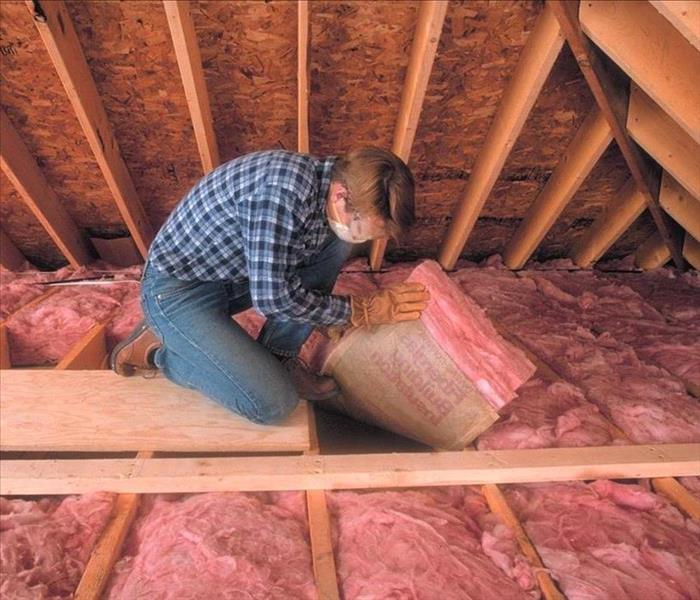 Checking the attic for soot damage can provide a better overall cleaning job
Checking the attic for soot damage can provide a better overall cleaning job
An often-overlooked item in cleaning up after a home or business fire is checking the attic and the condition of the insulation. Heat rises and when things are heated, they can get pressurized. Even a small kitchen fire can produce temperatures of over 1,000 degrees. The heat and pressurization can carry soot particles into the attic and the insulation can get covered with a fine layer of soot. Because the soot may be consistently deposited throughout the attic, it might not stand out.
A quick check of the roof sheeting and joists with a dry clean sponge can show if soot is a problem in the attic space. If it is, insulation should be evaluated for removal and replacement. Once the insulation is removed, the attic space should be cleaned with dry clean sponges and consideration made to encapsulate all raw wood surfaces to lock in those particles, so they do not cause soot smells to be released in those hot summer months.
We cleaned the kitchen after the fire but it still has a smoke smell
5/22/2019 (Permalink)
 Be sure to thoroughly deodorize to ensure a complete fire cleanup
Be sure to thoroughly deodorize to ensure a complete fire cleanup
Smoke particles are very small. They are so small that if you were able to stack smoke particles together, you would need 30-100 to equal the thickness of a human hair; that is small.
That means that soot can easily travel to other areas of the house and can get trapped inside the pores of other materials (cabinets, etc.) that were heated up during the fire. The problem is that those odors can be released from the pores of those items when the item is heated up again, say in the summer.
We help to get rid of those soot particles by warming up the home again as part of the cleaning process. We will warm up the house to say 85-90 degrees and then we deodorize with either ozone or hydroxyls.
It's a small thing, but we think it provides a better overall cleaning job and makes our customers happier, even if they don't know we did it!!
Doing things right!!
Soot cleanup is challenging
5/6/2019 (Permalink)
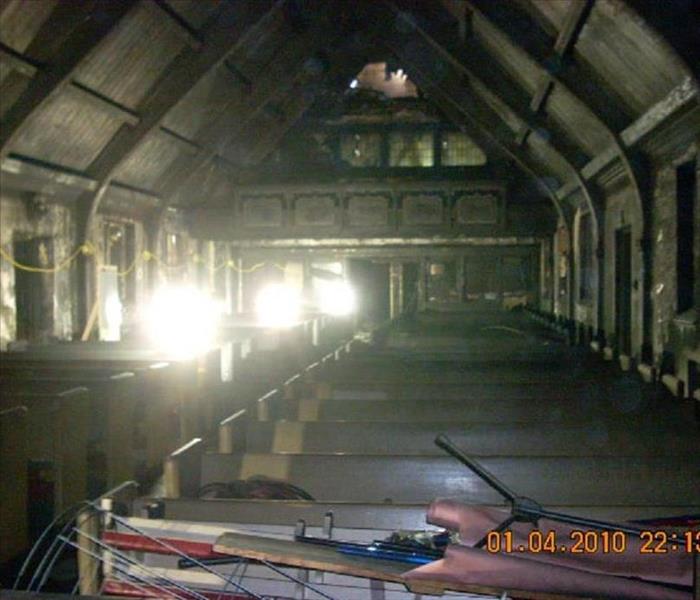 Fire in a 75 year old church
Fire in a 75 year old church
Smoke and soot is extremely invasive and can penetrate various cavities within your home, causing hidden damage and odor. Our smoke damage expertise and experience allows us to inspect and accurately assess the extent of the damage to develop a comprehensive plan of action.
Smoke and soot facts:
- Hot smoke migrates to cooler areas and upper levels of a structure.
- Smoke flows around plumbing systems, seeping through the holes used by pipes to go from floor to floor.
- The type of smoke may greatly affect the restoration process.
Different Types of Smoke
There are two different types of smoke–wet and dry. As a result, there are different types of soot residue after a fire. Before restoration begins, SERVPRO of Elgin/Northwest Kane County will test the soot to determine which type of smoke damage occurred. The cleaning procedures are then based on the information identified during pretesting. Here is some additional information:
Wet Smoke – Plastic and Rubber
- Low heat, smoldering, pungent odor, sticky, smeary. Smoke webs are more difficult to clean.
Dry Smoke – Paper and Wood
- Fast burning, high temperatures, heat rises therefore smoke rises.
Protein Fire Residue – Produced by evaporation of material rather than from a fire
- Virtually invisible, discolors paints and varnishes, extreme pungent odor.
Our Fire Damage Restoration Services
Since each smoke and fire damage situation is a different, each one requires a unique solution tailored for the specific conditions. We have the equipment, expertise, and experience to restore your fire and smoke damage. We will also treat your family with empathy and respect and your property with care.
Have Questions about Fire, Smoke, or Soot Damage?
Call Us Today – 847.697.8500
Cleaning the formerly uncleanable
4/29/2019 (Permalink)
 Esporta cleaning of leather purses
Esporta cleaning of leather purses
Fires in homes cause a lot of damage, that is not surprising. However, some content items are considered unsalvageable because there was never a cost effective means to cleaning them. As a result, many items are thrown away and are cluttering our landfills. That is not the case anymore!
By utilizing our newest cleaning system, Esporta, we are able to clean items that even professional clothing cleaners would not attempt. Esporta is a revolutionary cleaning system that uses Earth friendly cleaning products and a patented cleaning process that allows leather, as well as thousands or other items, to be cleaned quickly and thoroughly.
Imagine, cleaning leather goods, sports equipment and pads, helmets, as well as cloth dolls, comforters, all in a cost effective, highly thorough cleaning system.
SERVPRO of Elgin/Northwest Kane County, helping to make it "Like it never even happened."
Knowing what burned in the fire, helps determine the cleaning!
4/29/2019 (Permalink)
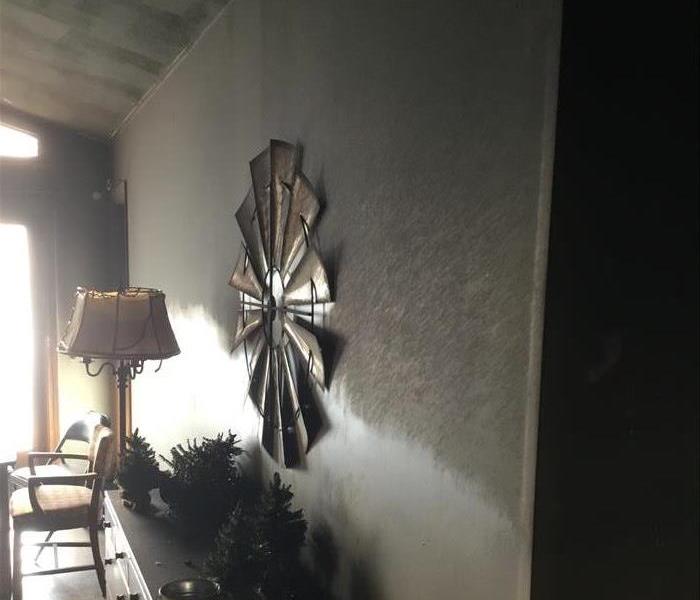 Extensive soot damage in a fire
Extensive soot damage in a fire
Smoke and soot are extremely invasive and can penetrate various cavities within your home, causing hidden damage and odor. Our smoke damage expertise and experience allow us to inspect and accurately assess the extent of the damage to develop a comprehensive plan of action.
Smoke and soot facts:
- Hot smoke migrates to cooler areas and upper levels of a structure.
- Smoke flows around plumbing systems, seeping through the holes used by pipes to go from floor to floor.
- The type of smoke may greatly affect the restoration process.
Different Types of Smoke
There are two different types of smoke–wet and dry. As a result, there are different types of soot residue after a fire. Before restoration begins, the cleaning procedures are then based on the information identified during pretesting. Here is some additional information:
Wet Smoke – Plastic and Rubber
- Low heat, smoldering, pungent odor, sticky, smeary. Smoke webs are more difficult to clean.
Dry Smoke – Paper and Wood
- Fast burning, high temperatures, heat rises therefore smoke rises.
Protein Fire Residue – Produced by evaporation of material rather than from a fire
- Virtually invisible, discolors paints and varnishes, extreme pungent odor.
Our Fire Damage Restoration Services
Since each smoke and fire damage situation is different, each one requires a unique solution tailored for the specific conditions. We have the equipment, expertise, and experience to restore your fire and smoke damage property.
Have Questions about Fire, Smoke, or Soot Damage?
Call Us Today – 847-697-8500
Smoke is a problem all on its own!!
4/16/2019 (Permalink)
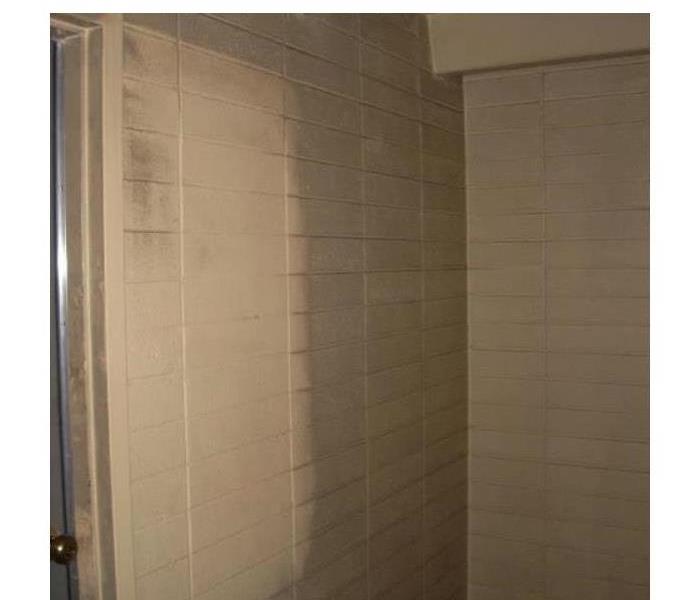 Different types of smoke need different cleaning methods
Different types of smoke need different cleaning methods
Smoke and soot are extremely invasive and can penetrate various cavities within your home, causing hidden damage and odor. Our smoke damage expertise and experience allows us to inspect and accurately assess the extent of the damage to develop a comprehensive plan of action.
Smoke and soot facts:
- Hot smoke migrates to cooler areas and upper levels of a structure.
- Smoke flows around plumbing systems, seeping through the holes used by pipes to go from floor to floor.
- The type of smoke may greatly affect the restoration process.
Different Types of Smoke
There are two different types of smoke–wet and dry. As a result, there are different types of soot residue after a fire. Before restoration begins, SERVPRO of Elgin/NW Kane County will test the soot to determine which type of smoke damage occurred. The cleaning procedures are then based on the information identified during pretesting. Here is some additional information:
Wet Smoke – Plastic and Rubber
- Low heat, smoldering, pungent odor, sticky, smeary. Smoke webs are more difficult to clean.
Dry Smoke – Paper and Wood
- Fast burning, high temperatures, heat rises therefore smoke rises.
Protein Fire Residue – Produced by evaporation of material rather than from a fire
- Virtually invisible, discolors paints and varnishes, extreme pungent odor.
Our Fire Damage Restoration Services
Since each smoke and fire damage situation is a different, each one requires a unique solution tailored for the specific conditions. We have the equipment, expertise, and experience to restore your fire and smoke damage. We will also treat your family with empathy and respect and your property with care.
Have Questions about Fire, Smoke, or Soot Damage?
Call Us Today – 847-697-8500
What can you do to restore all the content in your home?
5/1/2018 (Permalink)
 Fire affected content
Fire affected content
When SERVPRO of Elgin/Northwest Kane County is asked to respond to a house fire, we work very hard to ensure the homeowner fully understands the entire process. We can help explain our processes and let them know how long it will take to get their house cleaned and rebuilt and get them settled back to normal. Calling us at 847.697.8500 brings you the knowledge and caring of a professional team of restoration experts.
But what about your content? Content is basically everything in your house that would fall out if you were able to pick up your house and turn it upside down. Clothing, furniture, appliances, electronics, shoes, bedding, toys, etc. We are a FULL SERVICE content restoration company and we do EVERYTHING in-house. Textiles, leathers, furniture, electronics. One company who can handle all of your cleaning and restoration needs; including reconstruction.
SERVPRO of Elgin/Northwest Kane County is a Contents restoration Specialist with years of experience in properly restoring your families' content. We thoroughly inspect each item to determine the damage. If it is determined to be salvageable, we will identify the type of cleaning and deodorization method to utilize. Once each item is restored, we ask the homeowner to come to our state of the art warehouse and inspect their content themselves. We leave nothing to chance!!
SERVPRO of Elgin/Northwest Kane County should be your "go-to"company for all of your fire and smoke cleanup needs! Call us at 847.697.8500 to learn more about what we can do for you!!
Cleaning leather goods
4/24/2018 (Permalink)
 Before and after photo of heavily sooted high end leather purse
Before and after photo of heavily sooted high end leather purse
Fires in homes cause a lot of damage, that is not surprising. However, some content items are considered unsalvageable because there was never a cost effective means to cleaning them. As a result, many items are thrown away and are cluttering our landfills. That is not the case anymore!
By utilizing our newest cleaning system, Esporta, we are able to clean items that even professional clothing cleaners would not attempt. Esporta is a revolutionary cleaning system that uses Earth friendly cleaning products and a patented cleaning process that allows leather, as well as thousands or other items, to be cleaned quickly and thoroughly.
Imagine, cleaning leather goods, sports equipment and pads, helmets, as well as cloth dolls, comforters, all in a cost effective, highly thorough cleaning system.
SERVPRO of Elgin/Northwest Kane County, helping to make it "Like it never even happened."
Different types of fire require different cleanup
4/24/2018 (Permalink)
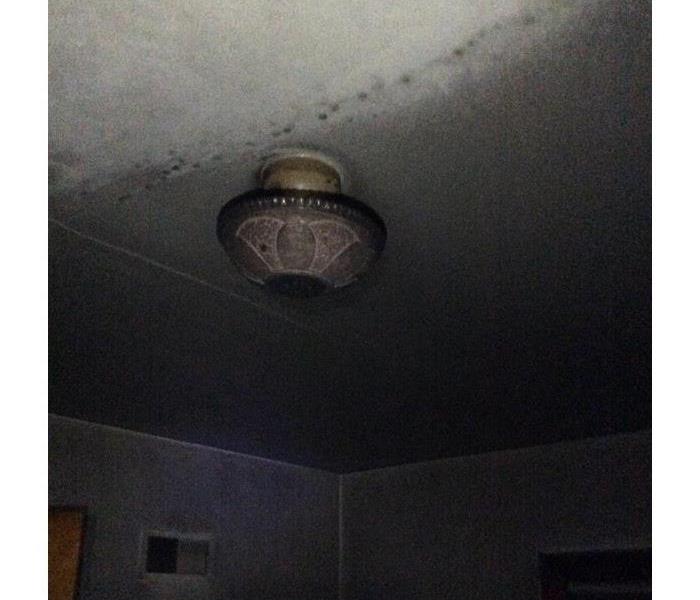 Soot damage after a serious fire.
Soot damage after a serious fire.
Smoke and soot is extremely invasive and can penetrate various cavities within your home, causing hidden damage and odor. Our smoke damage expertise and experience allows us to inspect and accurately assess the extent of the damage to develop a comprehensive plan of action.
Smoke and soot facts:
- Hot smoke migrates to cooler areas and upper levels of a structure.
- Smoke flows around plumbing systems, seeping through the holes used by pipes to go from floor to floor.
- The type of smoke may greatly affect the restoration process.
Different Types of Smoke
There are two different types of smoke–wet and dry. As a result, there are different types of soot residue after a fire. Before restoration begins, SERVPRO of Elgin/Northwest Kane County will test the soot to determine which type of smoke damage occurred. The cleaning procedures are then based on the information identified during pretesting. Here is some additional information:
Wet Smoke – Plastic and Rubber
- Low heat, smoldering, pungent odor, sticky, smeary. Smoke webs are more difficult to clean.
Dry Smoke – Paper and Wood
- Fast burning, high temperatures, heat rises therefore smoke rises.
Protein Fire Residue – Produced by evaporation of material rather than from a fire
- Virtually invisible, discolors paints and varnishes, extreme pungent odor.
Our Fire Damage Restoration Services
Since each smoke and fire damage situation is different, each one requires a unique solution tailored for the specific conditions. We have the equipment, expertise, and experience to restore your fire and smoke damage property.
Have Questions about Fire, Smoke, or Soot Damage?
Call Us Today – 847-697-8500
Smoke damage in commercial high rises
3/3/2018 (Permalink)
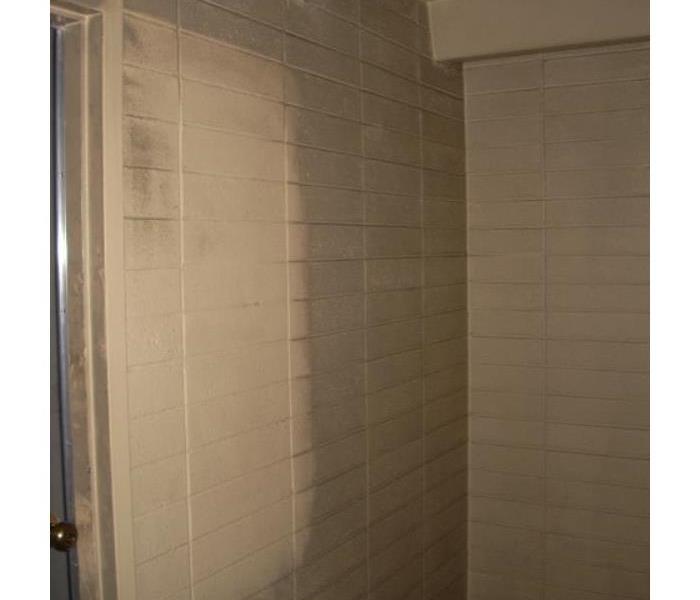 Fires and smoke in stairwells of multi-level buildings allows smoke to travel to all areas of a building.
Fires and smoke in stairwells of multi-level buildings allows smoke to travel to all areas of a building.
Smoke and soot is extremely invasive and can penetrate various cavities within your home, causing hidden damage and odor. Our smoke damage expertise and experience allows us to inspect and accurately assess the extent of the damage to develop a comprehensive plan of action.
Smoke and soot facts:
- Hot smoke migrates to cooler areas and upper levels of a structure.
- Smoke flows around plumbing systems, seeping through the holes used by pipes to go from floor to floor.
- The type of smoke may greatly affect the restoration process.
Different Types of Smoke
There are two different types of smoke–wet and dry. As a result, there are different types of soot residue after a fire. Before restoration begins, SERVPRO of Elgin/NW Kane County will test the soot to determine which type of smoke damage occurred. The cleaning procedures are then based on the information identified during pretesting. Here is some additional information:
Wet Smoke – Plastic and Rubber
- Low heat, smoldering, pungent odor, sticky, smeary. Smoke webs are more difficult to clean.
Dry Smoke – Paper and Wood
- Fast burning, high temperatures, heat rises therefore smoke rises.
Protein Fire Residue – Produced by evaporation of material rather than from a fire
- Virtually invisible, discolors paints and varnishes, extreme pungent odor.
Our Fire Damage Restoration Services
Since each smoke and fire damage situation is a different, each one requires a unique solution tailored for the specific conditions. We have the equipment, expertise, and experience to restore your fire and smoke damage. We will also treat your family with empathy and respect and your property with care.
Have Questions about Fire, Smoke, or Soot Damage?
Call Us Today – 847-697-8500
Every fire is different and requires specialized cleaning methods
2/6/2018 (Permalink)
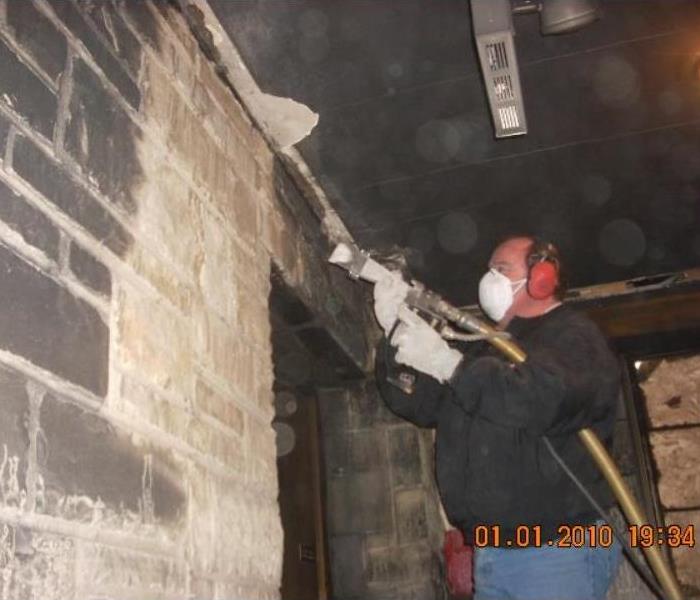 Cleaning soot off of stone wall with dry ice blasting
Cleaning soot off of stone wall with dry ice blasting
Smoke and soot is extremely invasive and can penetrate various cavities within your home, causing hidden damage and odor. Our smoke damage expertise and experience allows us to inspect and accurately assess the extent of the damage to develop a comprehensive plan of action.
Smoke and soot facts:
- Hot smoke migrates to cooler areas and upper levels of a structure.
- Smoke flows around plumbing systems, seeping through the holes used by pipes to go from floor to floor.
- The type of smoke may greatly affect the restoration process.
Different Types of Smoke
There are two different types of smoke–wet and dry. As a result, there are different types of soot residue after a fire. Before restoration begins, SERVPRO of Elgin/Northwest Kane County will test the soot to determine which type of smoke damage occurred. The cleaning procedures are then based on the information identified during pretesting. Here is some additional information:
Wet Smoke – Plastic and Rubber
- Low heat, smoldering, pungent odor, sticky, smeary. Smoke webs are more difficult to clean.
Dry Smoke – Paper and Wood
- Fast burning, high temperatures, heat rises therefore smoke rises.
Protein Fire Residue – Produced by evaporation of material rather than from a fire
- Virtually invisible, discolors paints and varnishes, extreme pungent odor.
Our Fire Damage Restoration Services
Since each smoke and fire damage situation is a different, each one requires a unique solution tailored for the specific conditions. We have the equipment, expertise, and experience to restore your fire and smoke damage. We will also treat your family with empathy and respect and your property with care.
Have Questions about Fire, Smoke, or Soot Damage?
Call Us Today – 847.697.8500
What to do and not to do after a fire?
6/2/2017 (Permalink)
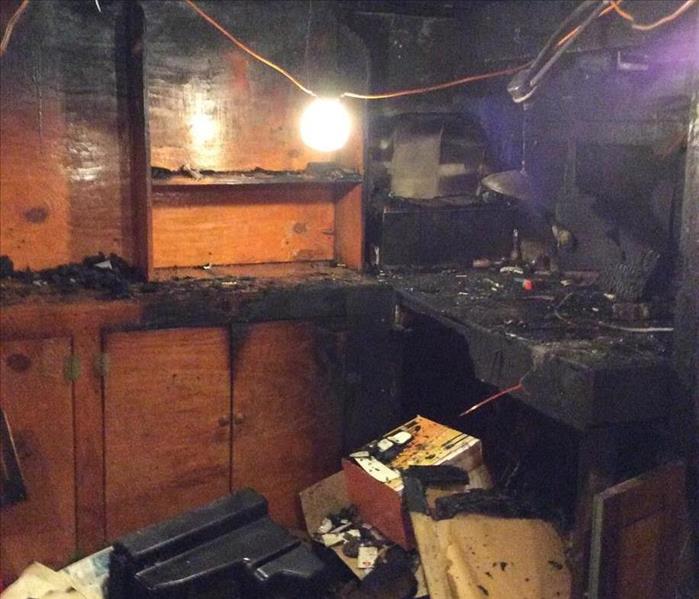 Fire affects everything.
Fire affects everything.
After any fire damage situation, your primary focus should be safety first:
- Is it safe to stay in the house? It might be best to have a professional evaluate first.
- Electrical and "slip and fall" hazards are some of the most prevalent concerns.
- Only do activities that are safe for you to perform. Cleaning up after a fire loss can be very specialized work
- Wet materials can be VERY heavy. Be careful!
What To Do After A Fire
- Limit movement in the home to prevent soot particles from being embedded into upholstery and carpets.
- Keep hands clean so as not to further soil upholstery, walls and woodwork.
- Place clean towels or old linens on rugs, upholstery and carpet traffic areas.
- If electricity is off, empty freezer and refrigerator and prop doors open.
- Clean and protect chrome with light coating of petroleum jelly or oil.
- Wash houseplants on both sides of leaves.
- Change HVAC filter.
- Tape double layers of cheesecloth over air registers.
What NOT To Do After A Fire
- Don't attempt to wash any walls or painted surfaces or shampoo carpet or upholstery without contacting us.
- Don't attempt to clean any electrical appliances that may have been close to fire, heat or water without consulting an authorized repair service.
- Don't use any canned or packaged food or beverages that may have been stored near the fire, heat or water.
- Don't turn on ceiling fixtures if ceiling is wet. The wiring may be damaged.
- Don't send garments to an ordinary dry cleaner. Improper cleaning may set smoke odor.
When your home and belongings have been damaged due to fire and smoke, call the experienced and knowledgeable staff at SERVPRO of Elgin, 847.697.8500, to make it "Like it never even happened."
Returning homeowner content to like new condition after a fire
5/18/2017 (Permalink)
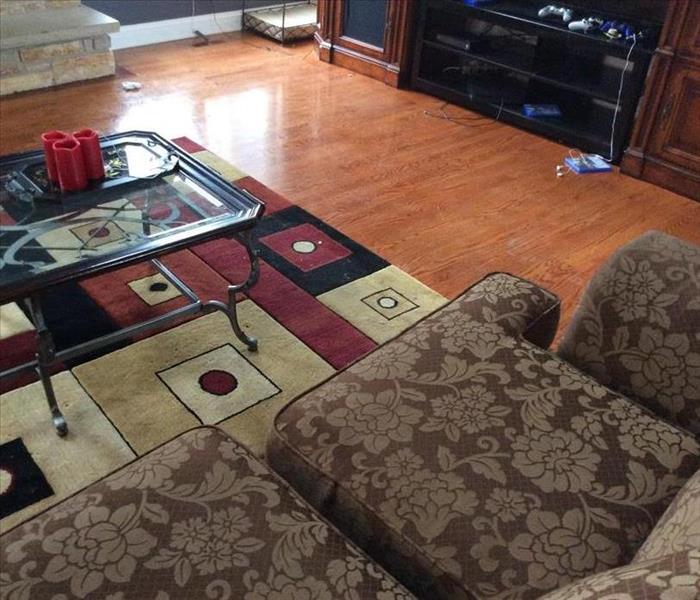 How many different content items can you see in this single photo?
How many different content items can you see in this single photo?
When SERVPRO of Elgin is asked to respond to a house fire, we work very hard to ensure the homeowner fully understands the entire process. We can help explain our processes and let them know how long it will take to get their house cleaned and rebuilt and get them settled back to normal. Calling us at 847.697.8500 brings you the knowledge and caring of a professional team of restoration experts.
But what about your content? Content is basically everything in your house that would fall out if you were able to pick up your house and turn it upside down. Clothing, furniture, appliances, electronics, shoes, bedding, toys, etc.
SERVPRO of Elgin is a Contents restoration Specialist with years of experience in properly restoring your families' content. We thoroughly inspect each item to determine the damage. If it is determined to be salvageable, we will identify the type of cleaning and deodorization method to utilize. Once each item is restored, we ask the homeowner to come to our state of the art warehouse and inspect their content themselves. We leave nothing to chance!!
SERVPRO of Elgin should be your "go-to" company for all of your fire and smoke cleanup needs! Call us at 847.697.8500 to learn more about what we can do for you!!






 24/7 Emergency Service
24/7 Emergency Service
